The first Splatoon gave us a new way to play multiplayer shooters, a genre that sometimes feels stale. Two years later, Splatoon 2 doesn’t revitalise shooters all over again but instead refines Nintendo’s unusual, brilliant take.
Splatoon 2, out now for the Switch, is a third-person shooter in which you battle with ink, not bullets. Ink harms your enemies, but more crucially, also paves the way forward: any ink that you spritz, you can swim through. Instead of some buff and gruff adult, you play as a cute kid who can also transform into a squid. If this sounds bizarre, well, you live in a post-apocalypse where marine life evolved unexpectedly. In this world, squid kids are in a never-ending war against humanoid octopi, all over decreasing energy sources and vanishing landmasses. Splatoon lore is absurd, and I like it.
Splatoon games are known for their multiplayer but once again, the single-player campaign is quite good. For those of us who played the first game, the stakes in the solo mode are immediate: Callie, the pop star singer featured in Splatoon 1, has gone missing, and it’s your job to find out what happened to her.
As a player of the Wii U original, I felt partially responsible for this turn of events. It all happens because Callie lost an in-game popularity contest that Nintendo ran in in 2016. While the mystery pulled me in, the stellar platforming kept me hooked.
The game’s solo adventure is spread across five different worlds, each with its own hub. The overworld alone delighted me, because finding the next level was often a mini-puzzle unto itself. I loved poking, prodding, and inking up anything I could find, all in the name of “how the hell do I get up there?” I also found myself tracking down all the balloons hovering throughout the overworld, which, if popped, would trigger timed races across the map. It is a testament to Nintendo’s design that just existing in their playhouse without even starting the proper game can feel so rewarding.
Once inside, the actual levels are a surrealist mash-up of floating platforms and mutated sea life. The goal is almost always the same: collect the energy source at the end of the level. Within that structure, Splatoon 2 constantly switches the finer details. In one level, you might find yourself grinding up ink rails, or riding around on your enemies, if not trying out all sorts of inventive weapons. My favourites include an umbrella shotgun, and a literal bucket of paint. Leave it to Nintendo to turn a paintbrush into a deadly weapon.
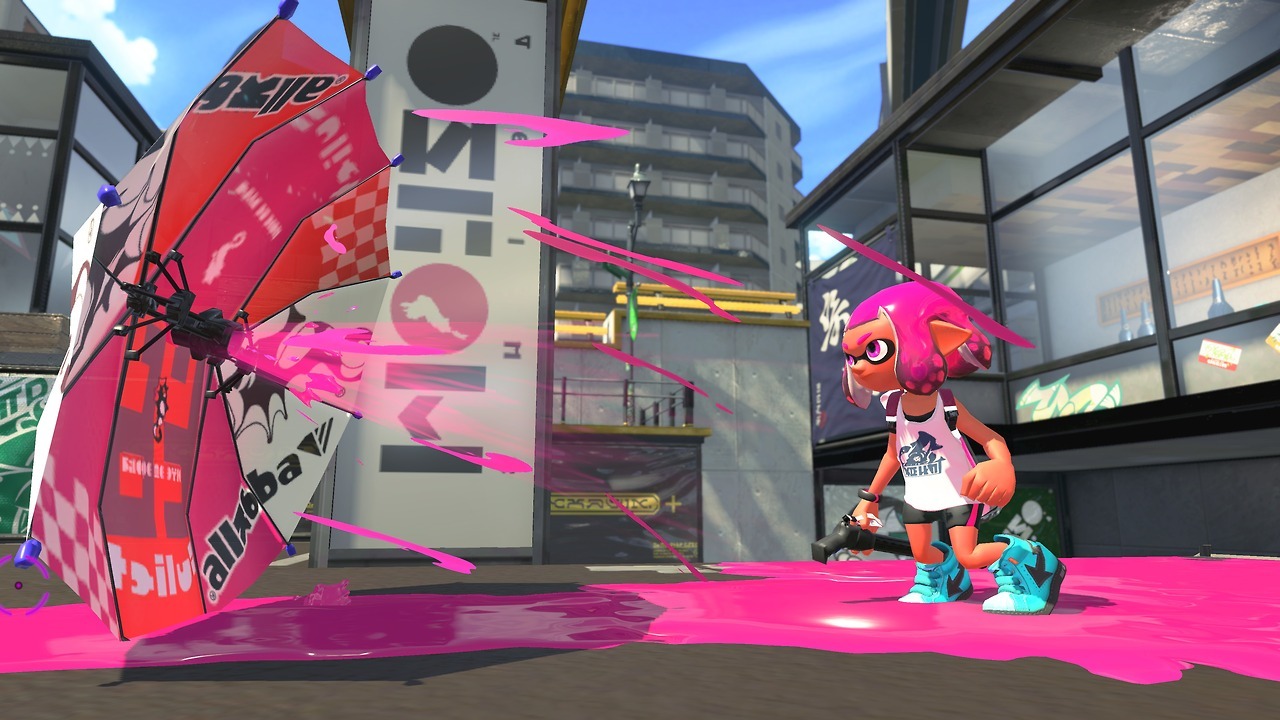
It’s easy to barrel forward through these levels, as you jump from platform to platform, only stopping to tear down whatever enemies stand in your way.
Still, I took my time and soaked it all in. Levels in Splatoon 2 feel dream-like, with everyday items like giant water bottles and stop signs dotting the landscape. You figure, this is how a child must look at the world. The precise neatness of a video game headshot is nowhere to be found here: your ink splatters with the rawness of an exploding water balloon. Cover as much as you can. Make a giant mess, and then roll around in it. Just mind the gaps.
Most of my time with Splatoon 2 has been spent within the multiplayer, which has a community I adore. I love to walk around in the lobby, where I can see what all the other squids are wearing. I love to see the art and jokes that people post on their avatars. I love taking selfies with other players. Inkopolis Square, which serves as a hub for all of Splatoon 2‘s activities, is one of the coolest video game spaces that you can explore.
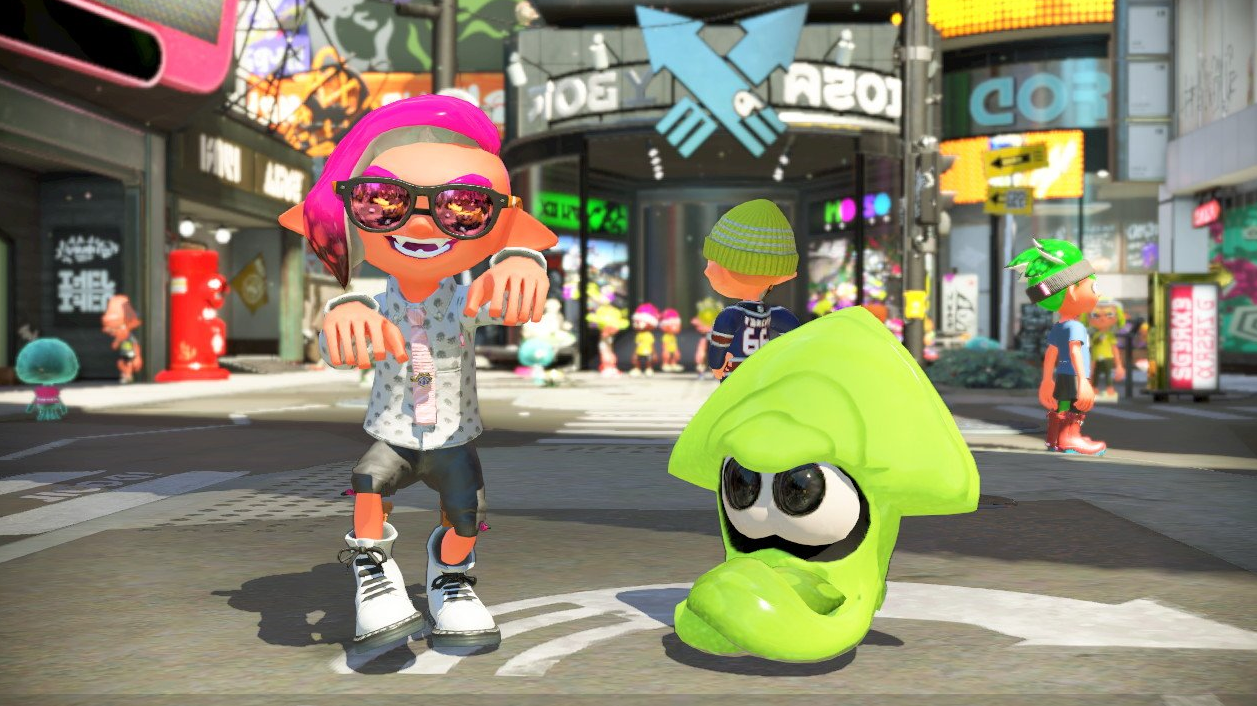
In “Turf Wars,” Splatoon’s famous mode, two teams of four players each fight over territory control. The more space your team inks, the more points you rack up. At the end, the game tallies how much paint is on the ground, and the team with more map coverage takes it all. You can win a match — hell, you can be top of the leaderboard — without ever killing another player. And so, most players start shooting the moment a match begins, and don’t stop pulling the trigger until the end whistle. Gotta cover as much as you can, man.
Often, matches devolve into an endless back and forth between players. Central areas change hands constantly, as players cover up the other team’s ink again and again. Splatoon is the living embodiment of the Duck Season / Rabbit Season GIF, except with bright colours:
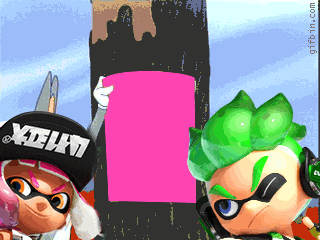
All of this makes me an obsessive player. I feel the urge to fill in any spots my teammates missed. I feel the urge to reclaim any enemy territory, no matter how small. It’s an instinct that probably gets me killed constantly, but I can’t help it. Must. Spread. Ink.
While Splatoon 2 may not function like most shooters, you’ll still find some standard multiplayer paradigms. You can, for instance, play a long-range sniper if you’d like. The difference is that, by throwing ink into the mix, the pace of a match changes. In the previous example, yes, you can pick off enemies from afar with your sniper. In addition to that, every shot you take also lays down a long stream of ink that you or your teammates can use to forge a path, while also suppressing where your enemy can go. Your firepower dictates everyone’s movement.
Swimming through ink introduces a wide variety of possibilities. You can climb up walls, and fall through grates.You can whiz around your enemy at mach speed. You can hide in a puddle of ink until the perfect ambush presents itself. Matches might only last three minutes, but the number of things that can happen during that timeframe is almost overwhelming.
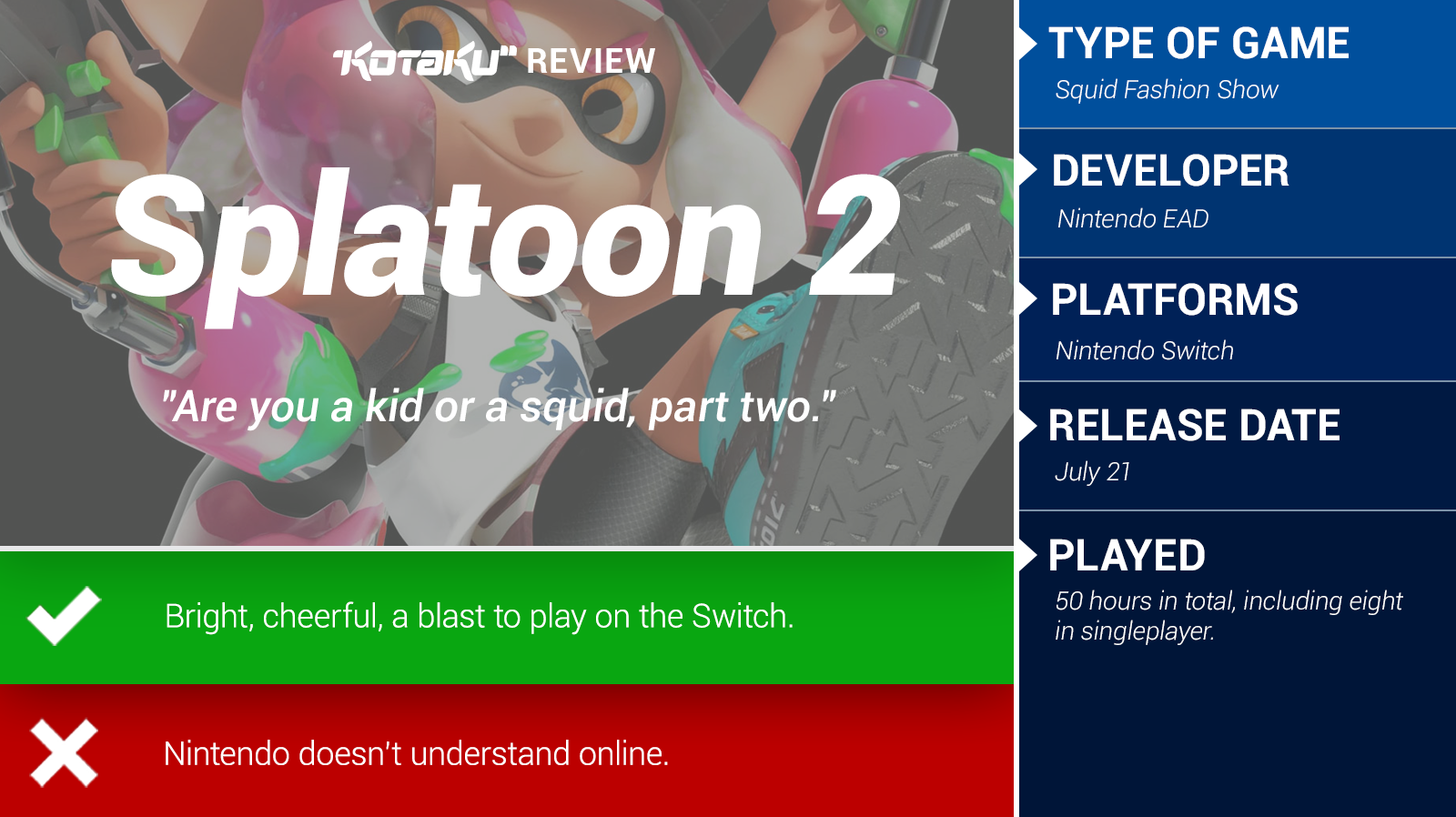
I’ve poured dozens of hours into the multiplayer because it’s fun, yes, but mostly, it’s because fresh threads are pricey. I have spent an embarrassing number of hours putting together different outfits in Splatoon 2, trying to find a good balance between form and function. Each piece of gear alters your abilities — right now, for example, I’m wearing some clothes that let survive enemy ink for longer. My shopping addiction isn’t help by Splatoon 2’s new mobile app, which has a constantly rotating stock of clothes. I’ve spent a lot of time just unlocking new ability slots on my gear, levelling up every cute thing that I buy, even if I’m not going to use it. Help.
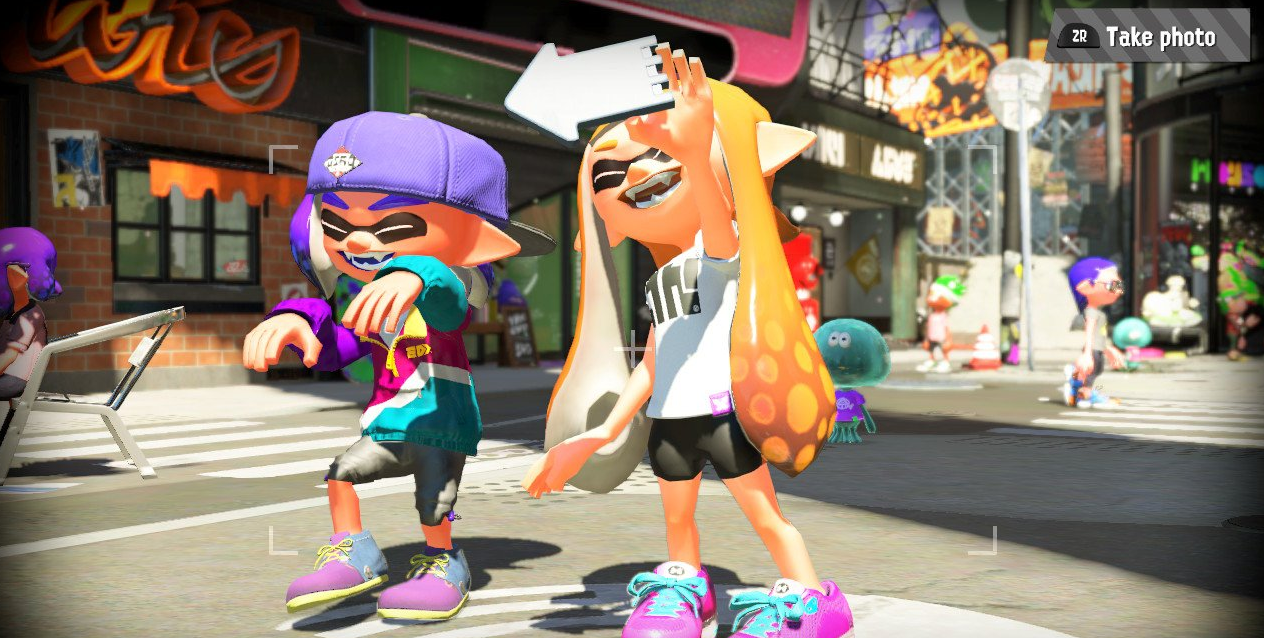
A lot of the preceding might sound familiar to the millions of people who played the first Splatoon. It’s why some fans debate whether Splatoon 2 is worth calling a full sequel. How, aside from the machine it’s running on, is it really different? The most visible change is in the graphics themselves. You’ll note that characters have more complex animations, and that the colours and shadows pop more than they did in the first game. There are way more clothes, and some new customisation options.
On the multiplayer side, not only have weapons been rebalanced, map quality is higher at launch launch. As an example, consider the Musselforge Fitness, a gym with filled with smaller obstacles and platforms of varying heights, from climbing walls to foam pits. Just finding new ways to get around is a joy.
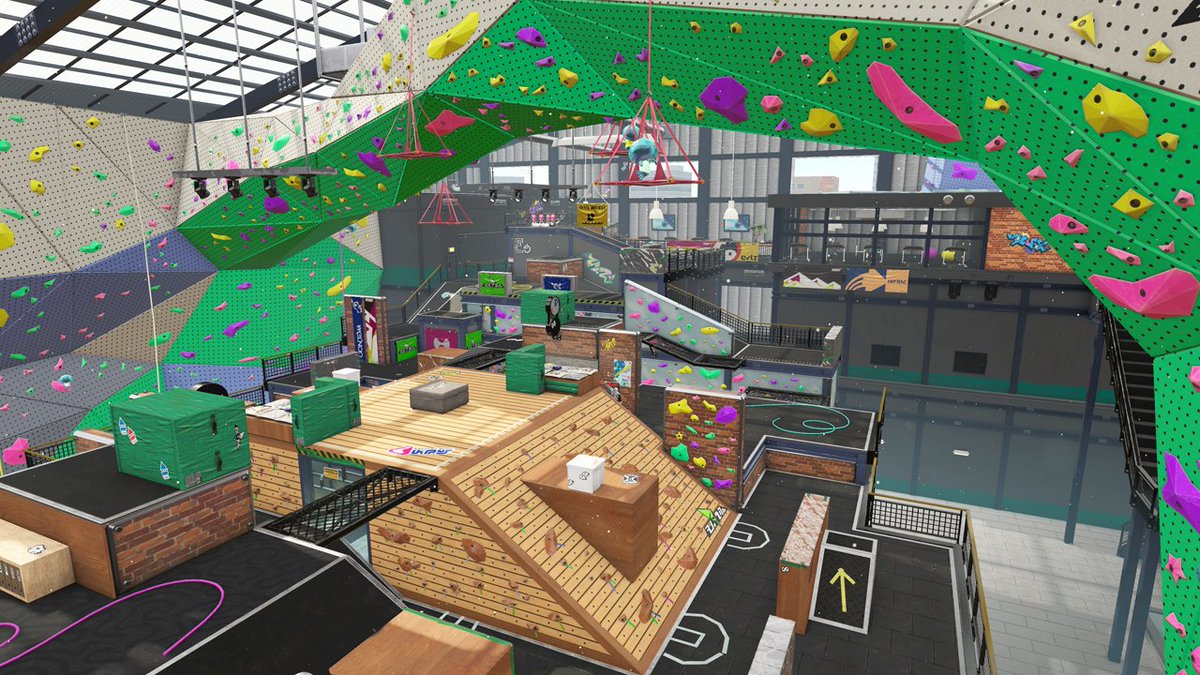
The whole game feels good, not just in the manner of it being fun or it being satisfying to pull off a win. Like the first game, some of Splatoon 2 offers a neon take on skating culture, skateparks, spray paint, and all.
Really, there’s just a pervasive feel-good vibe to everything in the game. Bickering doesn’t unfold over ranks or K/D, but rather inconsequential stuff like “Mayo versus Ketchup.” These are the sort of lighthearted arguments that unfold during Splatfests, occasional events where players must choose and defend a side. And no matter which side wins, we all get to see the game’s new pop idols put on a show between matches, so who cares?
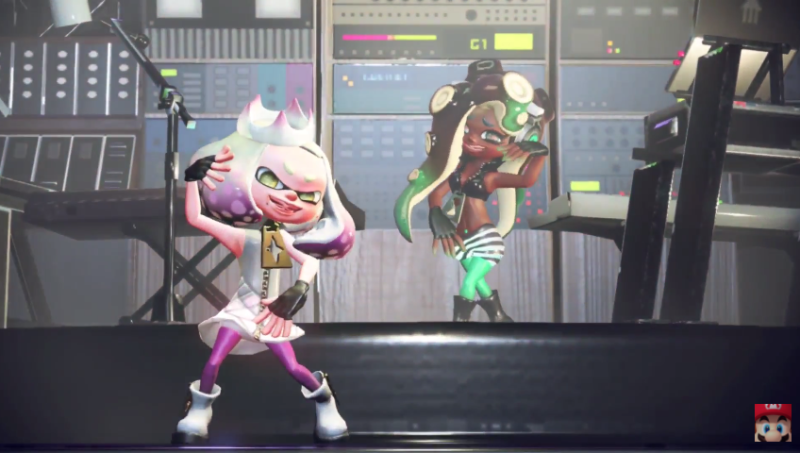
Nintendo has also added a terrific co-op component to the game. It’s called Salmon Run and is a horde mode where two to four players fight an ocean of enemies while collecting eggs for a grizzly bear. It’s all set on an oil platform surrounded by irradiated, toxic waste. You are there on behalf of a corporation that, I’m guessing, probably had you sign a waiver just to be there. The whole thing is sketchy.
Enemies come in waves, sludging up the terrain with their ink. Each round, players get a random weapon, and with it, a constantly shifting role to play. Every so often, a boss-type spawns into the map and causes a ruckus. Depending on the difficulty level, things can get frantic fast. The only way to make it out alive is to work together, and fortunately, Splatoon 2 lends itself wonderfully. Depending on how many eggs you reclaim, you’ll gain levels and win anything from new gear, to tickets that can give you limited-time bonuses.
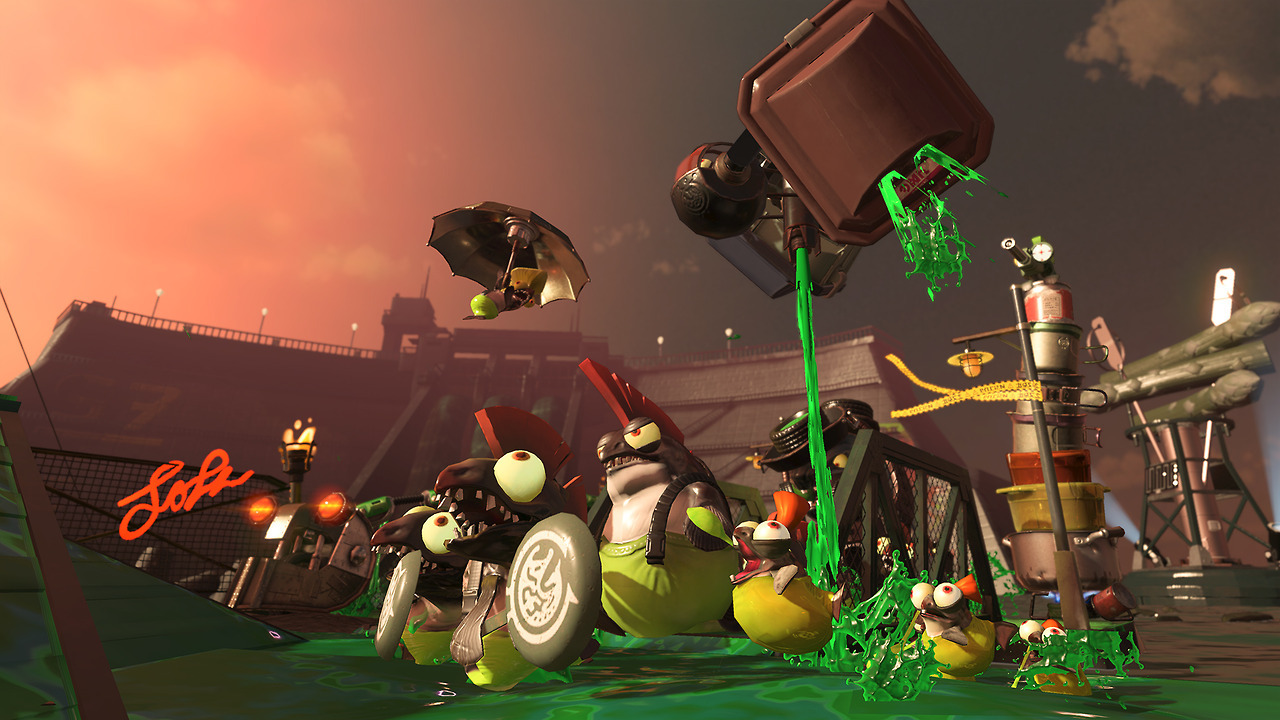
Unfortunately, the game’s competitive and co-op modes are hampered by a statement about Nintendo that’s as true as “this company makes Mario games”: Nintendo still can’t seem to get its online act together. I’ve lost track of how many things Splatoon 2 gets wrong about matchmaking.
Why can’t I back out of a lobby once I’m searching for a game? Why can’t I queue up with my friends and actually stay on the same team? Why do I have to download an app to talk with my teammates? Why are modes limited to two maps at a time? Why are modes like Salmon Run only playable online at specific hours? These are such basic issues, which become all the more baffling when you consider that many of them were present in the first game.
Thankfully, even if Nintendo’s online for Splatoon 2 is bungled and functional at best, the game is helped a lot by being on the Switch, a console that other people actually own. You can play the game’s multiplayer modes in person against other Switch players, or take it all with you on-the-go.
For players who enjoyed the first game, Splatoon 2 is not a reinvention, but it doesn’t have to be. It adds here and there, retaining what was best about the cheerful original while giving it a graphical upgrade and portability. Splatoon 2, at its best, is still Nintendo with confidence and flair.
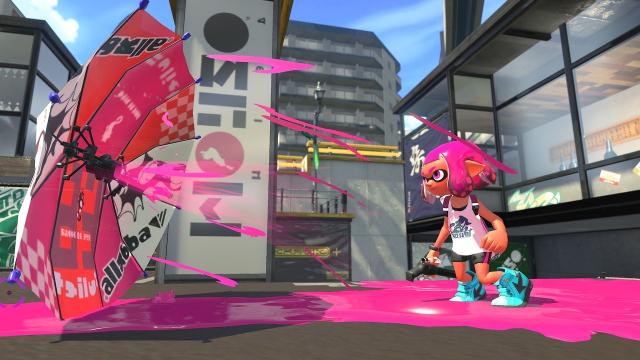
Comments
9 responses to “Splatoon 2: The Kotaku Review”
I am having massive connection issues with this game to the point it’s unplayable.
The advice online is my wifi must be trash which is most defiantly is not!
Connection unstable, anyone else getting this?
Also this article desperately needs a proof read 🙁 – “higher at launch launch” “clothes that let survive enemy”
I’ve played mine a fair bit with not a single drop out. Might be worth trying a hardwired connection.
No issues here, and I’m on wifi.
I was away on the weekend and was using my phone as a wifi-hotspot, and even that didn’t have any issues. It could possibly be an issue with the Switch itself if its not your home wifi connection
It’s the switch. It’s odd I know they had a patch not long about to fix the weak wifi but ever since then I’ve had issues I never had originally. After launch my wifi was ok (not full strength but 2 bars no drop outs) but now when I dock the signal somtimes drops out and I have to disconnect from the wifi take the switch to my router reconnect with 3 bars then bring it back to my back room. Was having these issues with mario kart after a recent switch update but had no issues at mk launch.
I bought a cheap $20 wifi range extender and now it doesn’t drop out though, had zero issues with splatoon so far.
It’s a bit lame because in the same room i’ve had a ps4, xbox one, mobile, tablet, laptop, 3ds and 2 different android gaming devices and they all get a max strength wi fi signal. I’m guessing it’s just weak wifi (as others have reported) in the switch and some software issue with how it handles low signals possibly the dock blocking the wifi signal too abit.
Article most ‘defiantly’ needs a proof read indeed 😉
Touché but then again I’m not getting paid for grammatical accuracy in my comments. I defiantly stand by my comment 😛
A fantastic game hampered by a lot of issues the first game had. I wish I could swap a gear loadout easily without having to leave the entire lobby for example. I really can’t understand the wisdom behind that and they had all this time to fix it so all I can think is they deliberately wanted it to be that way?
Have you tried pressing “plus” button while in the lobby? Or at least, I don’t know, figure out what the heck is on your screen, or at least bottom right corner? I bet you are that kind of people who skip through text and words then complain why no one ever tells you about that before.
This is a one-shot message, don’t reply to it.
Nintendo being perverse and difficult?? No, never.
How disappointing that Nintendo’s Splatoon 2 can’t get online support I guess that means I’m have to go back and play the original Splatoon.